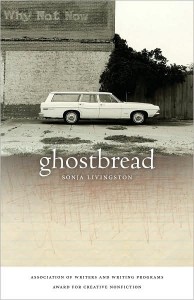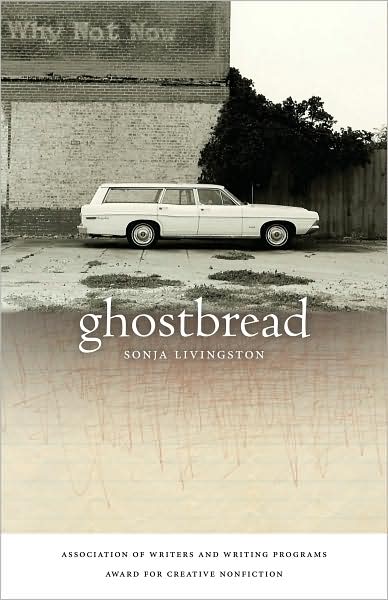50 LIBROS/ 50 BOOKS: Mujeres y sus historias.
In his poem “On turning 10”, Billy Collins says: “You tell me it is too early to be looking back,/ but that is because you have forgotten/the perfect simplicity of being one/ and the beautiful complexity introduced by two…” For Sonja Livingston it is not too early to be looking back because she knows well the imperfect simplicity of being one-too-many. Ghostbread deals with the bleak world of childhood; this memoir is a collection of bittersweet impressions of living with a large nomadic family, it is about looking back, about remembering the very imperfect simplicity of growing up.

Sonja Livingston. Ghostbread. The University of Georgia, 2009.
Already in her preface, Livingston states, “As a girl, I never talked about how I grew up. It was complicated. People might point fingers”. When time goes by she finally decides to pick up a pen, let herself go and write about “…children who followed a mother as she flew around western New York like a misguided bird”. Sonja Livingston, the “misguided” bird, invites us to observe where she came from and all the places she –and her family– had to go. For them, everything was temporary: pets, friends, gifts, and houses.
Ghostbread is divided in two chapters and is composed of 122 vignettes that are interconected but work as independent narrations. These vignettes are populated by different stories, stories of hope and despair, detailed portraits of those around the protagonist: from sisters and brothers to neighbors, teachers, priests, boyfriends.
My favorite person should have been Carol Johnson. Carol’s voice was like gravel, her words came out slow and sifted through the cigarette perpetually pressed between her lips. (7)
In each vignette the narrator introduces us to a new “acquisition”: a friend, a game, a house, a bed, a church; she also tells how she relate to “it” until it was time to let go. At the beginning the narrator describes where they live as a “neighborhood of untucked shirts and mismatched socks” (13), it seems that is pretty much the appearance of this family. They all have to endure life as it is.
My mother had other things on her mind. A new baby to feed, a sitter to pay, a job to hold on to. And boxes to pack. We’d lived in Albion for three years – a tiny eternity given our record – but we were heading out again.
Our stay in the crumbling house was over. (47)
Ghostbread stories become poetic tales that, as snapshots, show what is like to face two of the great evils of society: poverty and alienation. Sonja and her sisters and brothers are the mismatched socks everywhere they go. Still somehow they manage to have a time to enjoy themselves, to have fun. They manage not only to survive but also to merely live with grace.
Every now and then, she had a day off, and I’d manage to fake sick to gain trips to Carrol’s for burguers, to the downtown diner for grilled cheese, to Ames for stiffly coordinated outfits stuck to plastic hangers. Those rare stolen days were such a treat that I had to remind myself to appear sick… (Livingston 35)
Sonja Livingston tosses off overwhelming childhood events, the inner life of this child exposes us to the inner life of any given child. “If you cut me I could shine.” says Billy Collins in his poem, one can believe that even when cut, Sonja could shine, could reach; she manages to find the brightness and the poetry in all this grey, the beauty and the abyss in childhood. At the end, she states in the epilogue “…the thing that feeds us, no matter how tenuous, is what we will reach for…”
Sonja Livingston. Ghostbread. The University of Georgia, 2009.



Inspiring to look into another migrant family life. Our family was a migrant family during my early years and my parents early years of marriage; we moved several times a year following the crops beginning in the Salinas Valley of California. I kept track of where we lived by sitting down with my mother to put together a list of all the places we lived until miraculously we lived long enough in California to finish my entire high school at the same school. Before, on the average we lived from two to three different towns for every school year through the eighth grade. We learned a lot about constantly surviving in each new often hostile small town school. It was important to quickly determine who could be a friend and who was your enemy. However, unlike Sonja, our family unit was very stable and strong. You have to admire her and thank her for writing about it.